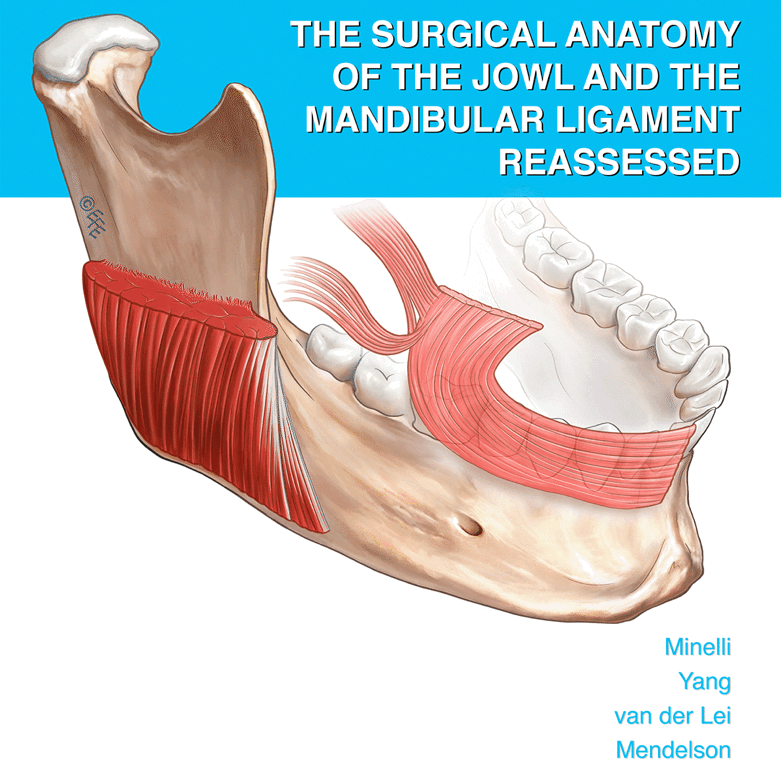Abstract
The anatomic basis for the jowl has not been fully described. A formal analysis was performed of the sub-superficial musculoaponeurotic system (SMAS) areolar tissue layer, which overlies the lower part of the masseter. For this research, facial dissections were performed on 16 fresh cadavers ages 12 to 89 years, and detailed anatomic observations were made during the course of several hundred rhytidectomy procedures. Tissue samples from varying age groups were examined histologically. The areolar cleavage plane overlying the lower masseter has specific boundaries and is a true space named the “premasseter space.” This space is rhomboidal in shape, lined by membrane, and reinforced by retaining ligaments. The masseter fascia lines the floor, and branches of the facial nerve pass under its deep surface. Histologically, the floor is formed by a thin layer of dense connective tissue, which undergoes minor deterioration in architectural arrangement with age. The roof, lined by a thin transparent and adherent membrane on the underside of the platysma, has a less dense collagen network and contains more elastin. With age, there is a significant reduction in the collagen density of the roof. Expansion of the space with aging, secondary to weakness of the anterior and inferior boundaries, results in formation of the jowl. Medial to the premasseter space is the buccal fat in the masticator space, which descends with aging and contributes to the labiomandibular fold and jowl. Application of the premasseter space in surgery provides significant benefits. The SMAS incision should be forward of the traditional preauricular location to be over the space, not behind. Because the space is a naturally occurring cleavage plane, dissection is bloodless and safe, as all facial nerve branches are outside. The premasseter space should be considered as the preferred dissection plane for lower (cervicofacial) facelifts.








Similar content being viewed by others
Notes
These dissections followed a formal coroner’s autopsy according to a protocol approved by the National Health and Medical Research Council (NHMRC) and the Human Research Ethics Committee (HREC) of the Victorian Institute of Forensic Medicine (VIFM), and after specific consent from the next of kin.
References
Baker DC (1997) Lateral SMASectomy. Plast Reconstr Surg 100:509–513
Clemente CD (2006) Anatomy, a Regional Atlas of the Human Body. 5th ed. Lippincott Williams & Wilkins: Philadelphia, USA
Dingman RO, Grabb WC (1962) Surgical anatomy of the mandibular ramus of the facial nerve based on the dissection of 100 facial halves. Plast Reconstr Surg 29:266
Furnas DW (1989) The retaining ligaments of the cheek. Plast Reconstr Surg 83:11
Furnas DW (1994) The superficial musculoaponeurotic plane and the retaining ligaments of the face. In: Psillakis JM (ed) Deep Face-Lifting Techniques. Thieme Medical Publishers Inc.: New York, NY
Gray’s anatomy. Williams, Warwick, Dyson, and Bannister (eds). 37th ed. Churchill Livingstone, 1989
Hamra ST (1992) Composite rhytidectomy. Plast Reconstr Surg 90:1
Hamra ST (2002) Surgical anatomy of the ligamentous attachments of the lower lid and lateral canthus: Surgical anatomy of the midcheek and malar mounds (discussion). Plast Reconstr Surg 110:900
Kahn JL, Wolfram-Gabel R, Bourjat P (2000) Anatomy and imaging of the deep fat of the face. Clin Anat 13:373–382
Labbe D, Franco RG, Nicolas J (2006) Platysma suspension and platysmaplasty during neck lift: Anatomical study and analysis of 30 cases. Plast Reconstr Surg 117:2001–2007
Little JW (2000) Three-dimensional rejuvenation of the midface: Volumetric resculpture by malar imbrication. Plast Reconstr Surg 105:267–285
Mendelson BC (2002) Surgery of the superficial musculoaponeurotic system: Principles of release, vectors, and fixation. Plast Reconstr Surg 109:824–825
Mendelson BC, Muzaffar AR, Adams WP Jr, (2002) Surgical anatomy of the midcheek and malar mound. Plast Reconstr Surg 110:885
Mitz V, Peyronie M (1976) The superficial musculoaponeurotic system (SMAS) in the parotid and cheek area. Plast Reconstr Surg 58:80–88
Morales P (2000) Repeating rhytidoplasty with SMAS, malar fat pad, and labiomandibular fold treatment: The NO primary procedure. Aesth Plast Surg 24:364–374
Moss CJ, Mendelson BC, Taylor GI (2000) Surgical anatomy of the ligamentous attachments in the temple and periorbital regions. Plast Reconstr Surg 105:147
Netter FH (1997) Atlas of Human Anatomy. 2nd ed. Novartis Medical Education: New Jersey
Pessa JE, Garza PA, Love VM, Zadoo VP, Garza JR. (1998) The anatomy of the labiomandibular fold. Plast Reconstr Surg 101(482):48–6
Snell RS (2003) Clinical Anatomy. 7th ed. Lippincott Williams & Wilkins: Philadelphia
Stuzin JM, Baker TJ, Gordon HL (1992) The relationship of the superficial and deep facial fascias: Relevance to rhytidectomy and aging. Plast Reconstr Surg 89:441
Tonnard P, Verpaele A, Monstrey S, et al. (2002) Minimal access cranial suspension lift: A modified S-lift. Plast Reconstr Surg 109:2074
Webster’s Third New International Dictionary. Merriam-Webster, Massachusetts, June 2002
Acknowledgments
The authors thank the VIFM, the Donor Tissue Bank of Victoria, and the respective families. They also thank Associate Professor Jeffrey Kerr and Mr. Ian Boundy from the Department of Anatomy and Cell Biology, Monash University, Victoria; Ian Bouch from the Department of Anatomy, the University of Melbourne; Ian Tew from the Zimmer Institute; Robert Ang; and the Department of Experimental Surgery, Singapore General Hospital for their assistance in this study.
Author information
Authors and Affiliations
Corresponding author
Rights and permissions
About this article
Cite this article
Mendelson, B.C., Freeman, M.E., Wu, W. et al. Surgical Anatomy of the Lower Face: The Premasseter Space, the Jowl, and the Labiomandibular Fold. Aesth Plast Surg 32, 185–195 (2008). https://doi.org/10.1007/s00266-007-9060-3
Published:
Issue Date:
DOI: https://doi.org/10.1007/s00266-007-9060-3




